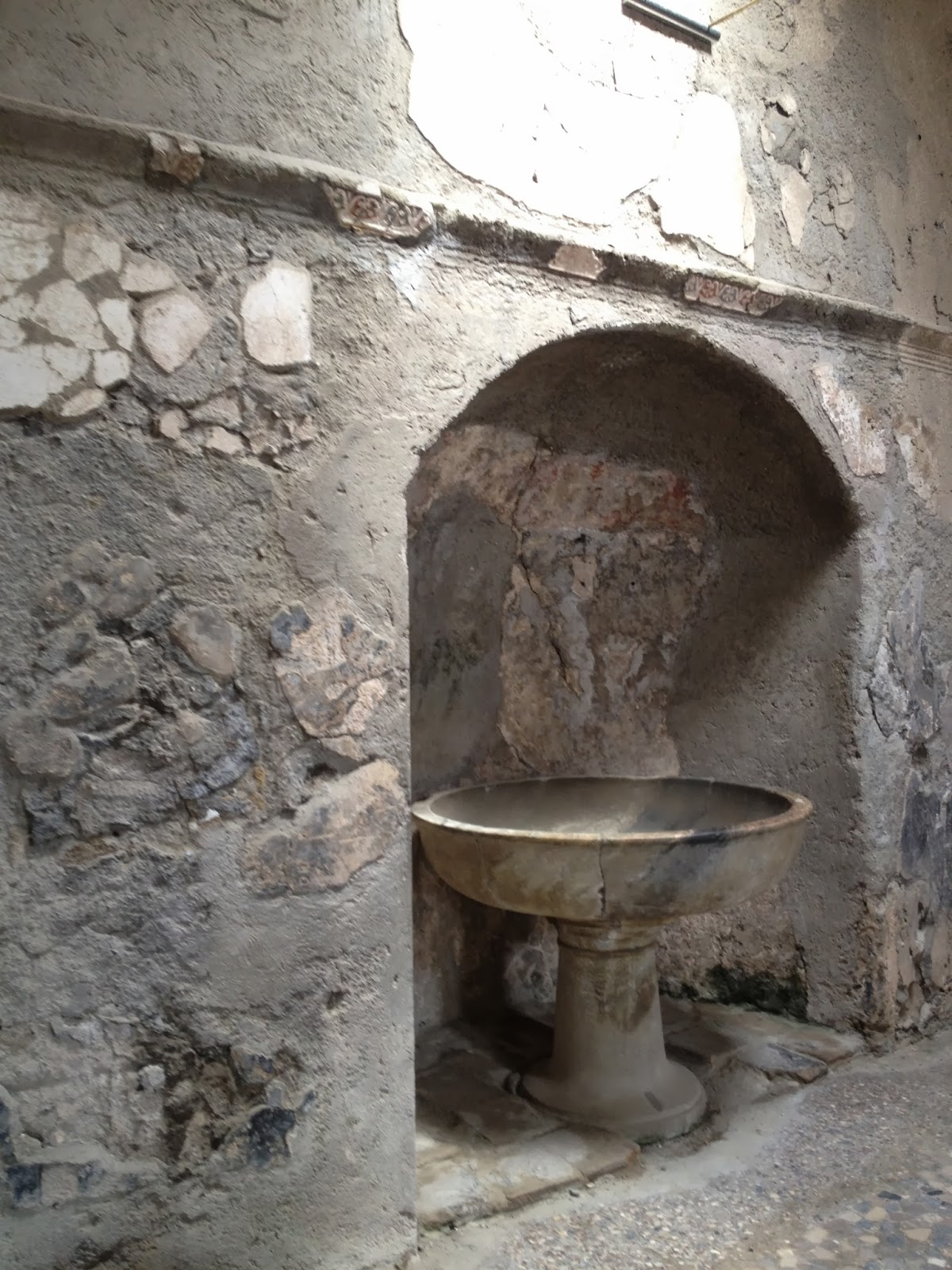Scavi di Ercolano, entrance to the excavations of Herculaneum
Naples, one of the oldest
continuously inhabited cities in Europe and also one of the largest, of which Johann
Wolfgang von Goethe said “see Naples and die,” is truly amazing. Founded in 470 BC by Greek traders, called
Nea-Polis meaning “new city” in Greek, Naples has been ruled by Romans, Ostrogoths,
Byzantines, Normans, Swabians, Angevin French, Aragonese, and Bourbons, until
Garibaldi united Italy in 1860. Our
short walk in the old part of Naples that we could reach on foot from the
harbor gave us the briefest of tastes of this magnificent history. I so wanted to break away from the tour and
visit Cumae, the mysterious site of the Cave of the Sybil, the prophetess of
the Roman kings and the site of the entrance to the Underworld in Roman
mythology, which was a mere 15 miles west of Naples, perhaps another time…
Soon we were back on the cruise
ship, and for the last time we gathered in the auditorium to join our
Herculaneum tour group. Pompeii and
Herculaneum -- the cities of Vesuvius, alive in my imagination for years. The
destruction and burial of these two Roman cities on 24 August 79 AD by the
volcanic eruption of Mt Vesuvius is so well known, and has been the subject of
TV movies and travelling museum exhibits.
But however much one has read, or how many movies seen, or museums
visited, there is no substitute for being there. And how real it felt, seeing Vesuvius looming
over the city, a mere 10 miles away, double-peaked now after many explosions,
with the scars of lava flows down the sides.
Herculaneum, with the volcano Mt Vesuvius in the distance
Herculaneum paved street. Note depth the city had been buried in 79 AD.
After a 20 minute ride, the tour
bus pulled into a non-descript parking lot at the edge of a non-descript town, no
sign of ancient city ruins that I could see.
However, once we entered the gate to the “Scavi di Ercolano” and looked down into the excavation area about
30 ft. below street level, we beheld the ancient city of Herculaneum. Called by some the Beverly Hills of Ancient
Rome, it was the resort city of the wealthy Romans, of large two-storey homes
decorated with magnificent frescoes, mosaics, and peristyle gardens, of public baths,
a huge 25,000 seat theatre, boat docks, and most telling, paved streets free of
the wheel-ruts that one sees in Pompeii, a more commercial and industrial city.
Herculaneum two-storey house, with some wall decorations still intact
Elegant home with a peristyle garden
There is a theatre buried within this wall of volcanic soil
Herculaneum was re-discovered in
1709 by some workmen digging a foundation for a nobleman’s villa, and for years
after the site was subjected to rampant tunneling and pilfering of marble statues
and bronze artifacts. Systematic
exploration and preservation only starting in the late 19th century,
hampered by the fact the modern town of Risina was built on the soil above the
ruins. Even now, most of Herculaneum is
entombed beneath Resina (renamed Ercolano) including the theatre. Today Herculaneum is a UNESCO World Heritage
site.
Herculaneum fast-food joint, the large jars held the food kept warm from the nearby furnace
Spectacular mosaic of Neptune and Amphitrite on the wall
Lararium for the household gods
Dr G in the atrium of the Samnite House
Labrum (wash basin) in the baths
Our tour guide walked us through
bakeries, cereal shops the thermal baths, aristocratic homes, and showed us a corner shop
that sold hot food and beverages from large terracotta jars, a sort of 2,000
year old fast food joint. We saw one
house with a mosaic floor that had buckled from the hot pyroclastic material
that buried it. We saw charred timbers
in the walls of another building, amazingly preserved. We saw the boat houses on what had been the sea
shore, where hundreds of skeletons were discovered in the 1800’s, dispelling
the common belief up to that time, that most of the citizens had escaped the
volcanic eruption.
The boat houses, where hundreds of skeletons were discovered, victims of the volcano
Tired, parched, and foot-sore, we
climbed back on the tour bus, almost solemn with the realization of what happened
here 1,934 years ago. To the east
double-peaked Vesuvius served as a reminder of the awful forces of Nature, and
how easily a paradise can be swept away.
We four explorers spent our last
evening together, the cruise completed.
After dinner and an evening nightcap, we bade each other farewell, with
L & G catching a flight back home, and C and I off to spend three days in
Rome. Then I planned to continue my
travels to Zurich while C caught a return flight. Our Mediterranean / Greek Island cruise dream
was over -- but what a wonderful time we all had!
Luggage lined up on the dock at the port of Civitavecchia, with buses ready to transport us back to the Rome airport. Cruise over *SIGH*
To be continued…













No comments:
Post a Comment